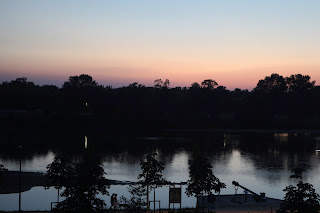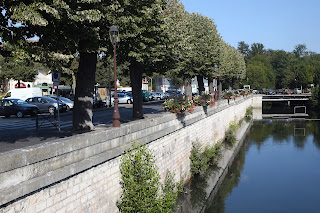We recently took a quick overnight trip to Reims, a town about 90 miles northwest of Paris. It was a quick trip in part because taking the high-speed train (called the TGV) from Paris to Reims takes just 45 minutes. We were able to take the same sort of train when we went to Strasbourg and made the 300 mile journey in two-and-a-half hours. It’s a pleasant change from flying: you can travel directly from Paris to the center of another city without needing to factor in time for getting to and from airports or going through security.
There is a lot of history packed into the small city center of Reims. It contained General Eisenhower’s headquarters during World War II and was where the German army surrendered to end the war in Europe. There are also a few Roman ruins: a gate built in 2nd century A.D. and the cryptoportique, an underground structure from the 3rd century A.D. that was used for grain storage.


Reims is also home to the cathedral where many of the coronations of the kings of France took place.
The cathedral was constructed between 1211 and 1311, but was partially demolished by shelling in World War I. It has been meticulously restored, but it is interesting to see the difference in color between the old and the new parts of the cathedral.
One thing we particularly enjoyed was the mix of original and modern stained glass windows. In addition to the windows that are as old as the cathedral itself, there were windows replaced in the 1970s and 1990s. My favorite was a window designed by the artist Marc Chagall. I am fond of the Chagall mosaic near Monroe & Dearborn in Chicago and his pieces in the Art Institute of Chicago, so it was really interesting to see his work in such a different setting.

But history aside, what we were really visiting Reims for was the champagne! Reims is the largest city in the Champagne region of France and many of the bigger champagne makers have houses (maisons) in town where you can take a tour of the cellars and taste the champagne. We decided to go to Reims just a few weeks before our trip and I didn’t try to book champagne tastings until about a week and a half prior to the trip. This was a big mistake - a number of the places that I contacted were booked up a couple of weeks in advance. I did manage to book a tour for each day, one at Mumm and the other at Lanson, but we would like to take another trip to see the places we missed.
Our two tours taught us a lot about how champagne is made. Champagne is a mixture of three different kind of grapes: pinot noir, chardonnay and pinot meunier. Grapes are harvested in many different villages, then crushed, and the juice from the different varieties and locations are all fermented separately. Both tours discussed the evolution of the fermentation vessels over time: oak barrels were used first, then ceramic tile-lined cement tanks, now stainless steel vats. On one of the tours we got to peek inside a decommissioned ceramic-lined tank. I was expecting a smooth lining, but it looked a lot like tile in a bathroom!
Once the grapes are fermented and have become wine, the winemaker blends different types together to produce the desired flavor. Vintage champagne is made with grapes that are all harvested in the same year, but only when the grapes are considered particularly good. Not every year is declared a vintage year. Most of the champagne that you see at the store, and any bottle that doesn’t specify a year on its label, is made by blending wine from from grapes harvested in different years. The winemaker chooses the blend that will match the character of the champagnes typically produced by that maker.
Once the champagne is blended, it is put into the bottles. Some yeast and sugar are added to start a second fermentation, and then the bottles are sealed using a cap, not a cork. The carbon dioxide gas produced during the second fermentation remains in the capped bottle as the carbonation in the champagne. When the second fermentation is complete, the wine is then aged. The fermentation leaves sediment in the wine, so after the aging the bottle is manipulated, either by machine or by hand, to gently shift the sediment into the bottle’s neck. The bottles are then immersed in some type of cooling medium while upside down, causing the sediment and liquid in the neck of the bottle to freeze. The bottle cap is then removed and the pressure that has built up inside the bottle from the carbonation pushes out the frozen sediment. Sugar is added to the champagne to produce the appropriate level of sweetness for the particular type of champagne and the bottles are corked and labeled.
The two tours we took were really interesting. Lanson’s tour includes their fermentation and bottling facilities in addition to the cellars. Mumm had a “museum” of old barrel-making and bottling equipment in one part of their cellars. On both tours, it was amazing to see the vast number of bottles aging or stored in the cellars.
We are both eager to go back to Reims or another part of the Champagne region, but luckily we can enjoy champagne here in Paris until we return!














































